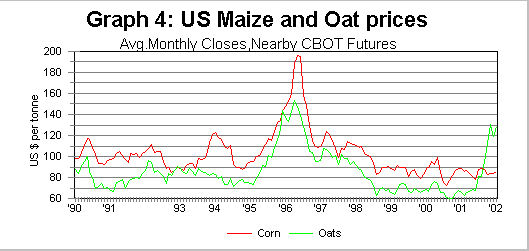|
Its hard to believe that any commodity could be more boring than oats. Its so boring, in fact, that no one even wants to eat it anymore. Food items like oatmeal and granola have fallen so far out of favor, that the world produces less than half the amount of oats it produced in the 1970's. Not only are its supply characteristics reminiscent of the kid who always got picked last at kickball, it only seems to be in demand when it's cheaper than anything else. And in there, lies the key to making money investing in this commodity. Grown almost exclusively in cold, moist environments, oats were a primary staple of Northern European diets decades ago. With increased trade, these people were able to import more food items from the south of Europe and became less dependant on oats for their survival. The ability to import food that was much more exciting than oats gave many Europeans a chance to experience something besides oatmeal for breakfast and many have not gone back. The United States, once one of the primary producers of the crop, is now the world's largest importer, with a hand in over 85% of the global traffic of oats. Much of the land space formerly devoted to oats has now been allocated to more profitable crops such as corn and soybeans. This pattern has been replicated all over the world for the past 30 years - if something else can grow in that space besides oats, inevitable the farmer will grow an alternative crop. If nothing else can grow on that farm, then the farmer is relegated to growing the ugly duckling of all crops - the oat. Today, this ugly duckling is grown only in the wasteland of agriculture - Sweden, Finland, Russia, and Canada, some of coldest, harshest environments in the world. The most boring part of the whole story however, is that the demand for oats is driven more by the price of corn than by anything else. Most of the commodity is used for animal feed, in which it competes against other crops, such as corn, which is the preferred method of feeding animals. As the price of corn rises, so does the price of oats.
While a Canadian drought in 2002 led to a temporary price spike, the market value for oats generally lags the price of corn by around $30/ton, making oats one of the cheapest foodstuffs on the market. As the world has expanded and living standards rise, it has become obvious that oats are less in demand. There is also some evidence that when living standards decline, oats become much more in demand (possibly because of its already cheap price). In fact, a recent study by two professors at Yale and UPenn showed the price of oats to decline in every phase of the business cycle, except during the late parts of a recession, where it was the best performer of all commodities. Perhaps the boringness of this crop to your taste-buds and friendliness of it to your pocketbook make oats the ultimate counter-cyclical crop. The Commodity Investor believes that in the midst of financial turmoil, when almost all asset classes (i.e. Stocks, Bonds, Real Estate, etc.) are spiraling downwards, oats may be one of the only investment classes that will appreciate in price. This unusual characteristic makes oats, a pretty exciting commodity.
|


